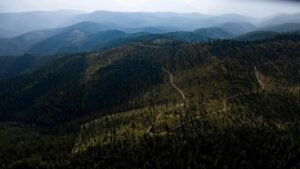They are impressive, mysterious structures that rise out of deserts on Earth and are also found on Mars and on Saturn’s largest moon, Titan.
Experts from universities including Aberystwyth in Wales have now dated the age of a star dune in a remote area of Morocco and uncovers details about its formation and how it moves across the desert.
Prof Geoff Duller from the department of geography and earth sciences at Aberystwyth said: “They are extraordinary things, one of the natural wonders of the world. From the ground they look like pyramids, but from the sky you see a peak and radiating from it in three or four directions these arms that make them look like stars.”
The team, which also included academics from the University of London, traveled to south-east Morocco to study a 100m high and 700m wide dune in the Erg Chebbi Sand Sea known as Lala Lallia, which “highest holy point” in the Berber language.
They discovered that the base of the dune was 13,000 years old, but were surprised that the upper part of the structure was only formed in the last 1,000 years or so. “It turned out to be surprisingly young,” Duller said.
The base continued to build until about 9,000 years ago. “Then the surface stabilized. We think it was a little wetter than today. We can see traces of old plant roots, suggesting that the dune was stabilized by vegetation. It seems to have remained that way for about 8,000 years. Then the climate began to change again and this star dune began to form.”
Duller said the dune was formed because the wind blows in two opposing directions – from the south-west and the north-east – which causes the sand to build up. A steady third wind blowing from the east slowly moves the dune to the west at a rate of about 50 cm per year.
“It’s important when you’re thinking about building roads, pipelines or any kind of infrastructure,” Duller said. “These things actually move.”
Light-dating techniques developed at Aberystwyth were used to discover when minerals in the sand were last exposed to sunlight to determine their age.
Duller said: “We’re not looking at when the sand was formed – that’s millions of years ago – but when it was deposited. The quartz grains have a property like a mini rechargeable battery.
“It can store energy it gets from natural radioactivity. When we bring it back to the lab, we can get it to release that energy. It comes out in the form of light. We can measure it and the brightness tells us when the grain of sand last saw daylight.”
One catch is that they must collect the grains of sand without exposing them to light. They did this by cutting pits in the dunes and hammering in an old piece of drain pipe to collect the samples.
“That part is not terribly high-tech,” Duller said. The work in the laboratory – which is much more high-tech and sensitive – must be carried out in the same kind of conditions as a photographic darkroom.
The same luminescence technique was used to date remains of what is believed to be the world’s oldest known wooden structurean arrangement of logs on the banks of a river bordering Zambia and Tanzania that predates the rise of modern humans.
The dune discoveries are published in the journal Scientific Reports.





